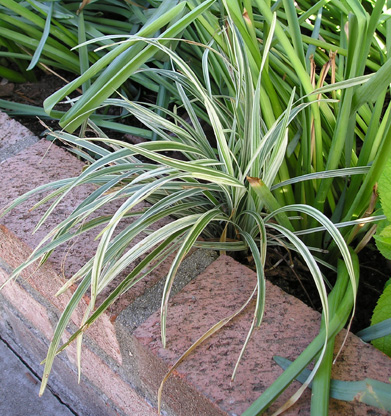- Liriope (genus)
Taxobox
name = Lilyturf

image_caption = Young variegated "Liriope spicata"
regnum =Plant ae
divisio = Magnoliophyta
classis = Liliopsida
ordo =Asparagales
familia =Ruscaceae
genus = "Liriope"
genus_authority = Herb.
subdivision_ranks = Species
subdivision =
*"Liriope muscari "
*"Liriope gigantea "
*"Liriope exiliflora "
*"Liriope spicata "Liriope is a
genus of low,grass -like,flower ingplant s fromEast Asia . Some species are often used in landscaping in temperate latitudes. They may be calledlilyturf inNorth America although neither a truegrass (familyPoaceae ) norlily (genus "Lilium "). Once classified with lilies in the familyLiliaceae , the genus is included inRuscaceae in theAPG II system."Liriope" are usually used in the garden for their evergreen foliage. Some species, e.g., "L. spicata", grow aggressively in the right conditions, spreading by runners; hence their nickname, "creeping lilyturf".
"Liriope spicata" is used as a substitute for
Ophiopogon japonicus inChinese medicine as an herb for yin deficiency. [Chinese Herbal Medicine Materia Medica Third Edition by Daniel Bensky, Steven Clavey, Erich Stoger and Andrew Gamble. Eastland Press, 2004]In the southeastern
United States Liriope is sometimes referred to by thenickname monkey grass or spider grass.The correct pronunciation of "Liriope" is subject to debate. It is frequently pronounced luh-RYE-oh-pee or lə-ˈrī-ə-(ˌ)pē, [Merriam-Webster's Collegiate Dictionary, Eleventh Edition] but there are many regional variations. In the southern United States, for example, it is often referred to as LYE-roh-pee, leer-EYE-oh-pee, or LEERY-ope.
References
Wikimedia Foundation. 2010.
